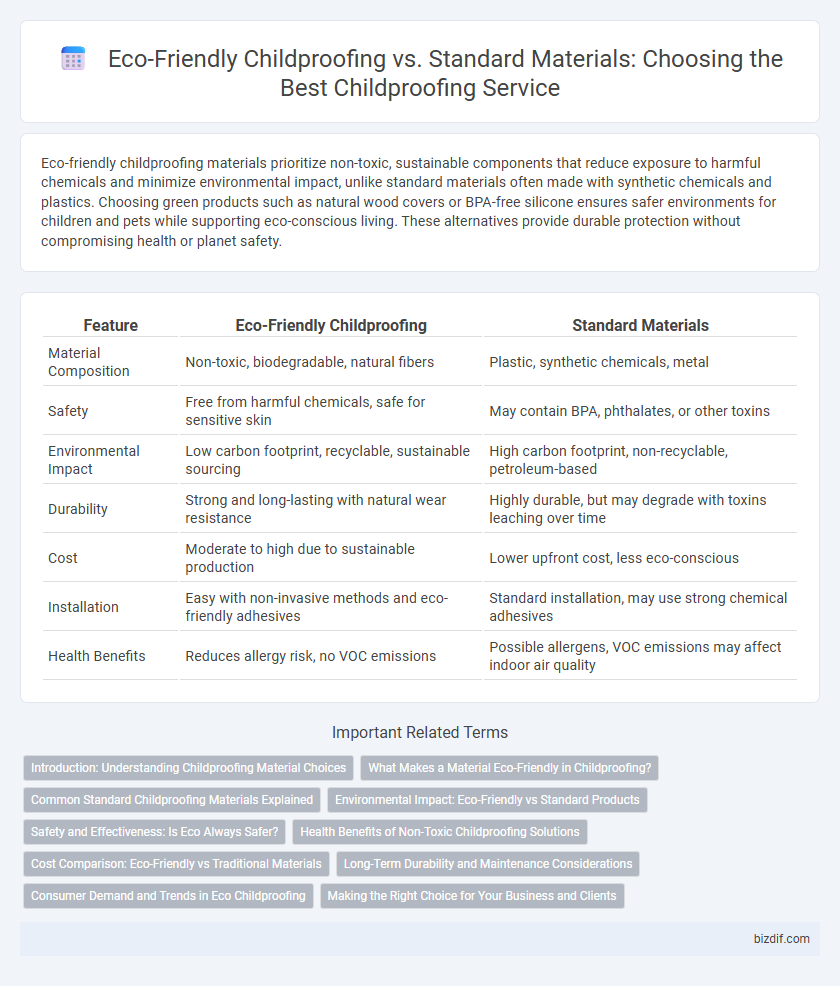Eco-friendly childproofing materials prioritize non-toxic, sustainable components that reduce exposure to harmful chemicals and minimize environmental impact, unlike standard materials often made with synthetic chemicals and plastics. Choosing green products such as natural wood covers or BPA-free silicone ensures safer environments for children and pets while supporting eco-conscious living. These alternatives provide durable protection without compromising health or planet safety.
Table of Comparison
| Feature | Eco-Friendly Childproofing | Standard Materials |
|---|---|---|
| Material Composition | Non-toxic, biodegradable, natural fibers | Plastic, synthetic chemicals, metal |
| Safety | Free from harmful chemicals, safe for sensitive skin | May contain BPA, phthalates, or other toxins |
| Environmental Impact | Low carbon footprint, recyclable, sustainable sourcing | High carbon footprint, non-recyclable, petroleum-based |
| Durability | Strong and long-lasting with natural wear resistance | Highly durable, but may degrade with toxins leaching over time |
| Cost | Moderate to high due to sustainable production | Lower upfront cost, less eco-conscious |
| Installation | Easy with non-invasive methods and eco-friendly adhesives | Standard installation, may use strong chemical adhesives |
| Health Benefits | Reduces allergy risk, no VOC emissions | Possible allergens, VOC emissions may affect indoor air quality |
Introduction: Understanding Childproofing Material Choices
Choosing eco-friendly childproofing materials reduces exposure to harmful chemicals like phthalates and formaldehyde often found in standard plastics and paints. Natural, non-toxic options such as organic cotton, bamboo, and low-VOC sealants promote safer indoor air quality and environmental sustainability. Families prioritizing green living benefit from durable, biodegradable products that ensure child safety without compromising health or eco-conscious values.
What Makes a Material Eco-Friendly in Childproofing?
Eco-friendly materials in childproofing prioritize non-toxic, sustainable, and biodegradable components such as organic cotton, natural rubber, and water-based finishes that reduce chemical exposure for children. These materials are sourced with minimal environmental impact, emphasizing renewable resources and low carbon footprints throughout their lifecycle. Choosing eco-friendly childproofing products supports safer indoor air quality and long-term health benefits by limiting harmful volatile organic compounds (VOCs) present in standard plastic and synthetic alternatives.
Common Standard Childproofing Materials Explained
Common standard childproofing materials include plastic, metal, and synthetic fabrics known for durability and cost-effectiveness but may contain harmful chemicals like BPA and phthalates. These materials often feature flame retardants and antimicrobial coatings that raise concerns for long-term child health and indoor air quality. Choosing eco-friendly alternatives made from non-toxic, biodegradable, and sustainably sourced materials reduces exposure to these potential hazards while maintaining safety standards.
Environmental Impact: Eco-Friendly vs Standard Products
Eco-friendly childproofing materials significantly reduce environmental impact through the use of sustainable, non-toxic, and biodegradable components, minimizing chemical emissions and waste. Standard childproofing products often contain plastics and synthetic chemicals that contribute to pollution and landfill accumulation. Choosing eco-friendly options supports long-term environmental health by promoting renewable resources and reducing harmful toxins in households.
Safety and Effectiveness: Is Eco Always Safer?
Eco-friendly childproofing materials often utilize non-toxic, natural substances that reduce exposure to harmful chemicals common in standard products, enhancing overall child safety. However, effectiveness depends on rigorous testing and certification standards, which some eco-friendly options may not consistently meet compared to conventional materials. Choosing childproofing solutions requires balancing chemical safety with proven durability and performance to ensure optimal protection for children.
Health Benefits of Non-Toxic Childproofing Solutions
Eco-friendly childproofing solutions utilize non-toxic, natural materials such as plant-based paints and BPA-free plastics to significantly reduce children's exposure to harmful chemicals like phthalates and lead. These health-conscious alternatives contribute to improved indoor air quality and lower the risk of developing respiratory issues, allergies, and neurodevelopmental disorders. Implementing sustainable childproofing methods ensures a safer living environment, promoting long-term wellness and minimizing environmental impact.
Cost Comparison: Eco-Friendly vs Traditional Materials
Eco-friendly childproofing materials often have a higher upfront cost than standard options but provide long-term savings through durability and reduced health risks. Traditional materials tend to be cheaper initially but may require frequent replacements and contain harmful chemicals that impact indoor air quality. Investing in sustainable, non-toxic products supports safer environments for children and can lower healthcare expenses related to chemical exposure.
Long-Term Durability and Maintenance Considerations
Eco-friendly childproofing materials, such as bamboo and non-toxic paints, offer long-term durability by resisting wear and minimizing exposure to harmful chemicals, making them safer for children and the environment. Standard materials like plastic and synthetic compounds may degrade faster, requiring more frequent replacements and potentially releasing toxins over time. Maintenance for eco-friendly options typically involves simple cleaning without harsh chemicals, preserving both the product's integrity and indoor air quality.
Consumer Demand and Trends in Eco Childproofing
Consumer demand for eco-friendly childproofing materials has surged due to increased awareness of toxic chemicals commonly found in standard products. Trends indicate a preference for sustainable, non-toxic, and biodegradable materials that ensure child safety while minimizing environmental impact. Manufacturers are responding by innovating with organic fabrics, natural wood, and plant-based finishes to meet the growing market for green childproofing solutions.
Making the Right Choice for Your Business and Clients
Choosing eco-friendly childproofing materials enhances indoor air quality and reduces exposure to harmful chemicals, promoting healthier environments for children and families. Sustainable products often feature non-toxic, biodegradable components that align with growing consumer demand for environmentally responsible solutions. Prioritizing green options differentiates your business by showcasing commitment to safety and sustainability, building stronger trust with eco-conscious clients.
Eco-Friendly Childproofing vs Standard Materials Infographic

 bizdif.com
bizdif.com